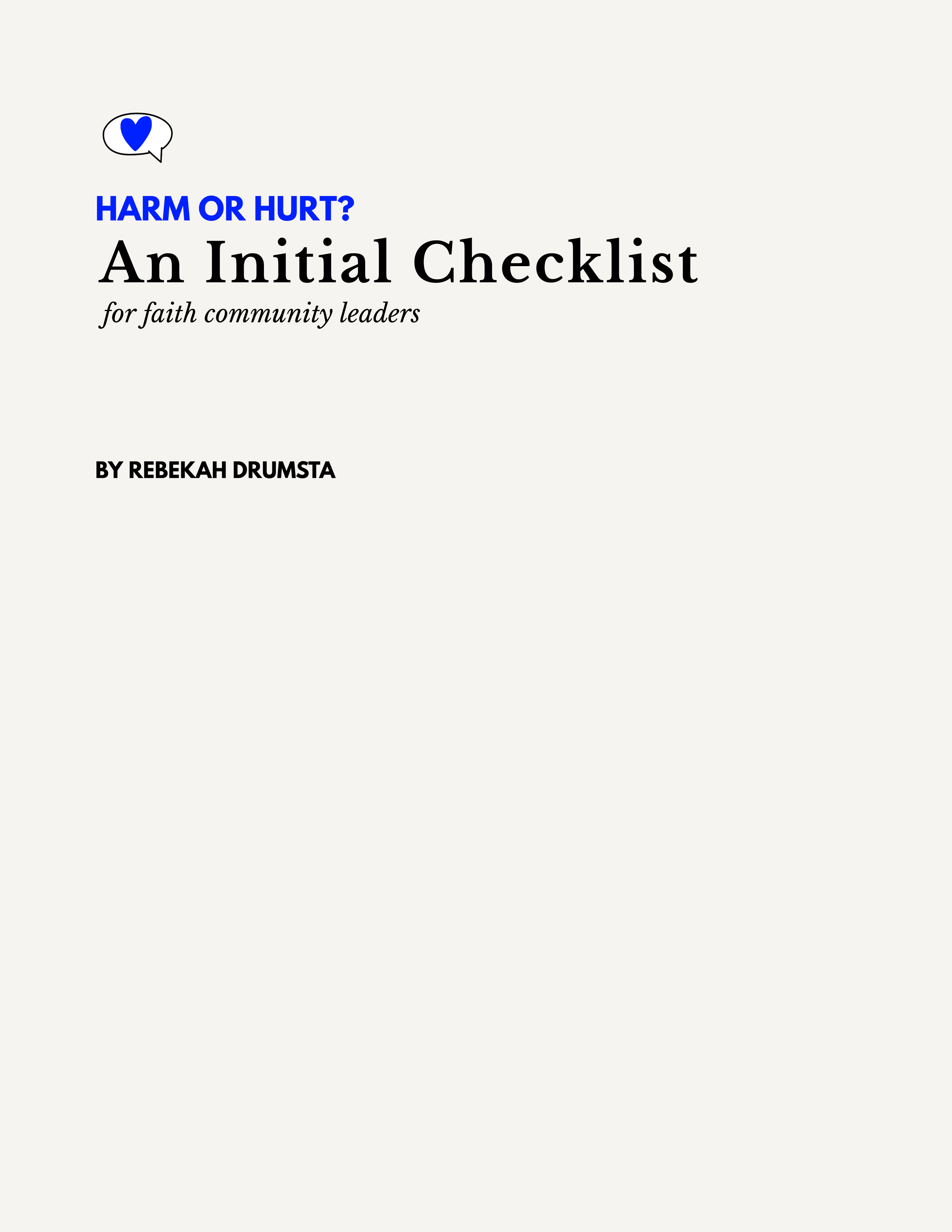Is “Church Hurt” Just a Bypass? When What We Don’t Name Lets Harm Off the Hook
This post might make things sticky for me. You know, tread lightly or else I’m gonna make some folks upset. But that’s not my style. It used to be, back when I blogged under another name because I was too afraid to use my full name - Rebekah Drumsta. I was afraid back then of what people would think of me, what they would do to me, what would happen if I asked the questions in my mind or express a different opinion.
The reality is those fears are real and I’ve experienced some consequences. But I’ve learned that not speaking up, not saying what I see, not challenging unhealthy, systemic religious norms-that’s not honest to who I am or how I was designed to be. So, even though I’m gonna step on some pretty or professional toes, I’m going to say it: (and I have Band-Aids if you need one, with cool patterns I might add)
The term Church Hurt is a form of spiritual bypassing that covers wrongdoing and minimizes the harm people have experienced.
The umbrella term, Church Hurt, makes things more palatable doesn’t it? “People are going to hurt us, but Jesus will never let you down! It’s time to forgive and move forward in doing life together.” Using the expression, Church Hurt, to label what it feels like when someone within your faith community has hurt or harmed you…in any way…is really just bypassing the real issues. It’s a cop-out, my friends. It softens wrongs into feelings, flattens systemic patterns into personal grief, and often prevents us from naming what actually happened.
Hear me out, please. I do have a “why.”
And keep reading for my FREE resource, “Harm or Hurt? An Initial Checklist for Faith Community Leaders.”
The Problem with Soft Language for Harm
Words shape the response. When behavior is labeled as “hurt,” the default becomes pastoral consolation and private prayer rather than investigation, safety planning, or restitution. A named wrong—abuse, coercion, betrayal—requires different actions than sympathetic listening.
Euphemisms protect reputation. Palatable labels make it easier for leaders or groups to say, “We’ll handle this quietly,” which too often means protecting the institution instead of protecting people.
Vague language erases patterns. Using the same soft term for different harms hides trends in leadership failure, cover-up, or cultural tolerance of misconduct. Patterns become invisible when we refuse to name them.
Survivors lose access to care and justice. Clinical support, legal options, and advocacy hinge on clear naming. When an experience is reframed as mere “hurt,” professionals and advocates can be sidelined.
Spiritualizing shrinks accountability. Framing harm as a spiritual test or relational failure moves the conversation from structural responsibility to personal piety and shifts the burden onto the wounded.
Ava’s Story
Ava joined a neighborhood church after moving to town, eager for stability, friendship, and a safe place for her family to worship. She served on hospitality, taught a children’s class, and trusted the pastor and elders who welcomed her.
When Ava’s marriage began to fail, she asked the pastor for counsel. He listened briefly, recommended more prayer, and arranged a discreet meeting with a couples mentor. The mentor’s advice focused on submission and keeping the home together; no one asked whether Ava felt threatened at home. A few weeks later she told a small group she was thinking about separation and experienced gossip faster than help. People’s smiles turned to avoidance. Invitations declined. A nursery worker who once hugged her now crossed the room.
Ava turned to church staff for guidance. An elder said the church needed to protect families and reputation and suggested that public airing of personal struggles could “hurt the flock.” She was encouraged to pursue reconciliation and to avoid “making waves.” The pastor offered prayer but no concrete support, referral, or safety plan.
When Ava sought counseling outside the church and her counselor recommended a safety plan, leadership said they didn’t want to take sides in a private marital matter. Her ministry involvement was quietly reduced, committees stopped calling, and close volunteers kept their distance. Ava left without a formal split. She stopped showing up and carried the quiet ache of being dismissed by the place she loved.
Ava’s story is not an isolated anecdote. It’s a composite of dynamics many people experience: exclusion, minimization, institutional protectionism, and the betrayal of a community that promised safety and belonging.
Why Precise Language Matters
Naming guides remedy. Specific words demand specific remedies. Abuse, coercion, shaming, and betrayal each require different protective and reparative responses.
Clarity prevents cover-up. When institutions insist on vague, comforting language, they create cover for harmful actors and for systems that enabled them.
Truth honors dignity. Survivors deserve language that reflects the reality of their experience. Softening testimony into a catchphrase robs pain of its moral seriousness.
Accountability prevents moral injury. Refusing precise naming compounds harm and creates moral injury for survivors, congregants, and leaders who witness avoidance. Transparency, process, and restitution are how trust can begin to be repaired.
Here are some of the words, some clarifying phrases, that might need to be used to replace Church Hurt:
Favoritism
Social exclusion
Poor communication
Abuse
Micromanagement
Unresolved conflict (or avoidance)
Betrayal
Lack of accountability
Unclear expectations
Disrespecting boundaries
Pressure to perform
Not feeling safe
Coercion
Etc.
Peer-to-Peer Harm Matters Too
Harm in faith communities isn’t only from leaders. Peers, fellow pew sitters, volunteers, and small-group members alike can exclude, shame, gossip, pressure for premature forgiveness, or weaponize spiritual language. These dynamics can be as injurious as leadership failures and deserve the same clarity, response, and boundaries.
Short peer scripts to avoid bypassing harm:
“I believe you. Thank you for telling me.”
“What would be most helpful right now—someone to listen, help with something, or a break from this group?”
“I’m not going to participate in gossip. How can I support your safety?”
Practical Steps for Leaders, Peers, and Supporters
Pause before you label. Replace reflexive Church Hurt with clarifying questions: What precisely happened? What immediate safety needs exist?
Use specific terms. Say abuse, manipulation, coercion, shaming, betrayal, or trauma. Specificity guides appropriate response.
Prioritize safety and referrals. Implement safety plans when needed and connect survivors with trauma-informed counselors, legal advice, and advocacy resources.
Create transparent processes. Publish clear reporting, investigation, and accountability procedures so concerns aren’t relegated to gossip or private counsel.
Train peers and volunteers. Teach small-group leaders and volunteers how to listen without minimizing and how to refer appropriately.
Center survivor autonomy. Believe testimony, prioritize survivor-directed safety, and avoid pressuring forgiveness or reconciliation as the first response.
You can also download this FREE resource, “Harm or Hurt? An Initial Checklist for Faith Community Leaders.”
Yes, I Anticipated Some Common Objections to My View of Church Hurt
Objection: “Using labels is divisive.”
Response: Naming harm is clarifying, not vengeful. Clarity creates the possibility of repair instead of enabling repeated harm.
Objection: “We must protect the church’s witness.”
Response: Protecting reputation at the cost of a person’s safety is a false witness; protecting reputation over people causes moral injury and corrodes communal integrity.
Objection: “Hurt happens in every community; we can’t police every slight.”
Response: Not every sting needs escalation. Name ordinary hurts so relationships can be repaired early; name harms so people receive protection and care for their bodies, minds, and spirits.
Objection: “This will fuel gossip and division.”
Response: Vague language drives rumor; clear naming paired with transparent process channels concern into accountability, not backyard gossip.Objection: “This undermines pastoral authority and the pastor’s role.”
Response: Pastoral care is strengthened when leaders face honest reporting and accountable systems; protecting people is the core pastoral duty.
Objection: “This politicizes pastoral care and invites outside scrutiny.”
Response: Accountability isn’t partisan; it’s protective. External scrutiny becomes necessary when internal systems prioritize reputation over people.Objection: “We risk false accusations if we name things too quickly.”
Response: Naming prompts appropriate procedures—safety assessment, documentation, and impartial investigation—not summary judgment.Objection: “People will weaponize labels to punish disagreement.”
Response: Robust processes prevent abuse of language; the answer is accountability structures, not silence.
Conclusion
We owe survivors (and each other) clearer language and safer responses. Softening wrongdoing into an easy phrase like Church Hurt lets institutions and individuals dodge accountability and lets real harm remain unnamed. If you lead, listen before you label and put structures in place that protect rather than placate. If you care for someone who has been wounded, believe them and center their safety. If you are tempted to smooth a story with a catchphrase, ask what you are covering up when you do. The answer might surprise you.
Honest language is not unkind; it is the first step to protection, repair, and a healthy community.
This article is not intended to treat or diagnose any condition.
Rebekah is not a licensed therapist or clinician. Any advice or opinions given on this site are strictly her own observation and insights based on personal experiences and study. It should in no way take the place of professional assistance.



